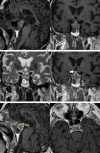Pituitary Apoplexy With Transition to Acute Hypophysitis in a Patient With Sars-CoV-2 Pneumonia
- PMID: 37908272
- PMCID: PMC10578393
- DOI: 10.1210/jcemcr/luac010
Pituitary Apoplexy With Transition to Acute Hypophysitis in a Patient With Sars-CoV-2 Pneumonia
Abstract
COVID-19 is a systemic disease associated with respiratory insufficiency, systemic inflammation, as well as coagulation, neurological, and endocrine disorders. Among them pituitary apoplexy (PA) as well as, more rarely, acute hypophysitis (AH) have been reported. In the present report, we described a case of PA in an 84-year-old man with SARS-CoV-2 pneumonia, with a previous unknown pituitary adenoma and a possible but not confirmed overlap with transitory AH. After reviewing the available literature, we discuss the potential clinical and pathophysiological relationship between PA and AH. Furthermore, we focus on the neuroradiological features of pituitary lesions in the presence of SARS-CoV-2 infection.
Keywords: COVID-19; SARS-CoV-2 pneumonia; hypophysitis; pituitary; pituitary apoplexy.
© The Author(s) 2022. Published by Oxford University Press on behalf of the Endocrine Society.
Figures



References
-
- Briet C, Salenave S, Bonneville J-F, Laws ER, Chanson P. Pituitary apoplexy. Endocr Rev. 2015;36(6):622–645. - PubMed
Publication types
LinkOut - more resources
Full Text Sources
Miscellaneous
